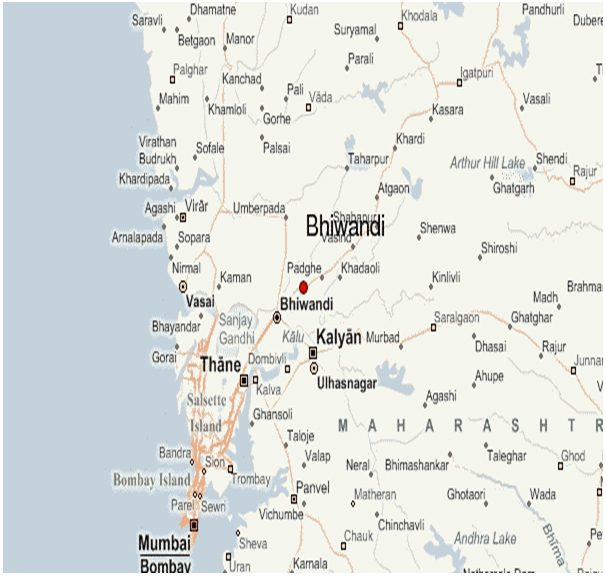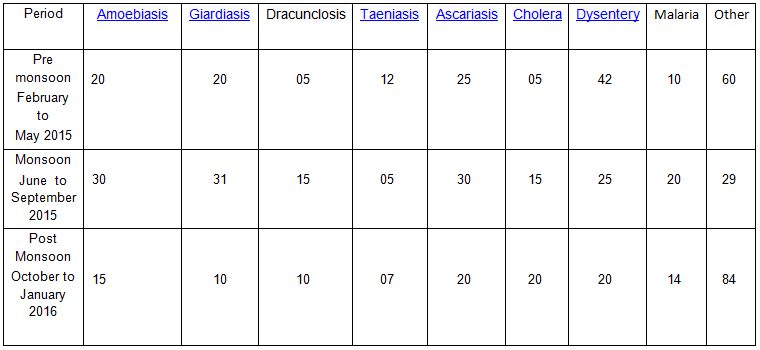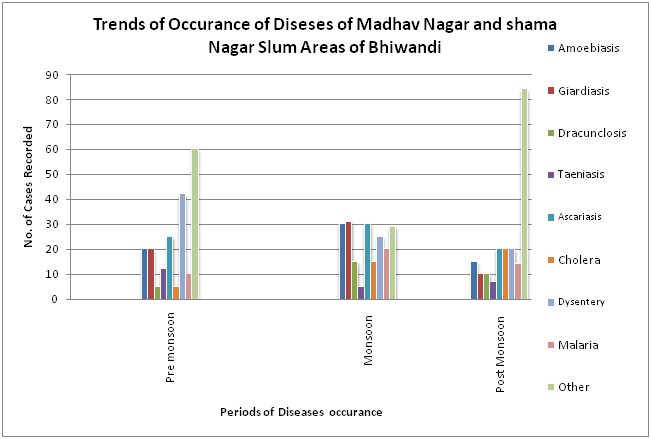Anis Ahmed B. Choudhery
Department of Zoology
G.M.Momin Women’s College, Bhiwandi,401302,
Dist.Thane, Maharshtra, india
Email: anischoudhery@gmail.com
Abstract
Bhiwandi is a small town and known as Manchester of Asia due to its Textile and handlooms. It is also known for its shifting population, city having highest workers population. Present study “Seasonal Trends of common water-borne diseases in the slum areas of Bhiwandi” was based on the surveys conducted by the NSS volunteers of G.M.Momin Women’s college in their adopted area Madhavnagar and Shamanager of Bhiwandi during years of 2015-16.
In town 65% of population were suffering from water borne diseases during the monsoon . Diseases like likedysentery, Amoebiasis, Giardiasis, Dracunclosis, Taeniasis, Ascariasis, Cholera, Malaria diarrhoea etc. this is very high number. These diseases were also found at its peak during summer period when water scarcity is highest and high number of people is utilizing ground water.
Keywords :- Bhiwandi, Waterborne diseases, questionnaire, Survey , Water Supply
Introduction
Bhiwandi is a small city, in the district of Thane, in state of Maharashtra (India). Located at 30 km to the north-east of Mumbai and 23 km to the north-east of Thane city. The exact location of Bhiwandi is 19.296664°N 73.063121°E.
As per Indian Census 2011 report population of Bhiwandi in 2011 is 709,665 of which 431,704 are males and 303,977 are females.

Map of Bhiwandi
The State government estimates that over 40 lakh people are dependent directly or indirectly on the power looms of Bhiwandi Nizampur. It is city of highest percentage of floating population.
Current population of this cosmopolitan city is above 1 million and most of them are associated with power looms, hand loom industries and working as loading and unloading workers in nearby godowns .
It was once the largest supplier of handloom textiles in India. It had great export demand in middle Asia and European countries. This city had golden era of skilled power loom workers of throughout India. Workers from Karnataka, Tamilnadu, Andrapradesh and Northern Indian state had populated this city. Merchants from Rajesthan, Gujrat and Maharshtra had huge investment and entire city was once richest township in India. BNC Carporation was once richest city Municipal Corporation in India. In early 90s due to arrival of power looms and blooming up cities like Ahamadabad and Surat, Bhiwandi lost its earlier charms but it is still known as ‘Manchester of Asia’ .
Meanwhile do to rapid industrialization and urbanization in nearby big township like Mumbai, Thane, Kalyan, Dombivili andNavi-Mumbai, the city become storage hub for all types of Industries . It has own largest number of godowns in India.
There are various economic reasons associated with it
Lower government tax
Closer to Airport,
Closer to JNPT and Railways’ yards.
Availability of space
Connecting Highways
Inspite of losing its dominancy in power looms and handlooms the city of workers managed to survived as they had no option and they had to convert them self from to skilled and experience labour to unskilled labouring. There was great monitoring loss for them and source of income was not constant now. Older people had less opportunity as young were prefer for loading and unloading in godowns.
Most of them become part of floating population of city without permanent settlement. It promoted rapid expansion of slum areas in town. During last two decades the population increased 200% and the basic facility and infrastructure was inadequate to sustain one the densest townships in India. Bhiwandi have largest proportion of 80% population living in different Slum areas like Nadi Naka, Khadipar, Shanti nagar, Gaibi Nagar Hanuman Tekri, Madhav Nagar, Shama Nagar, Diwan Shah, Eidgah Road etc.
There are various problems associated with the slum occupancies and most of them are related to health due to very unhygienic living environment, unawareness, hyper dense population and lack of basic facilities and infrastructures.
Potable water is the one of main concern, as nearly one million people of Bhiwandi have not access of adequate safe drinking water. Water is the basic necessity of life for all living beings. Adequate drinking water quality is essential for wellbeing of all humans who, not only use water for drinking but also at homes, in industry, agriculture, recreation etc.
Water quality deteriorates by natural phenomena or as a result of human activities making it less suitable for drinking and other uses because these pollutants could highly affect human health along with other living organisms.
Drinking water is supplied via surfaces, stored and ground water sources. These sources are always encountered with different type of pollutants (Rapidly Growing Megacities of Asia: Case of Karachi, Pakistan, A. Rahman, H.K. Lee, M.A. Khan).
Municipal Water Supply, Lake, Vendors and Well-water are the four major sources of water for domestic use in Bhiwandi. There were a river kaamvaari river in past in Bhiwandi but now only remains of this river is existing.
Objective of the Study
- Find out the impact of monsoon, pre-monsoon and post monsoon seasons on drinking water quality and rate of disease associated to it.
- Describe and evaluate trend and variation in Disease due to drinking water quality during Monsoon, pre-monsoon, and post-monsoon.
- Finding the causes of problems and effect of monsoon in drinking water quality.
- Proposing the possible solutions to help authorities in creating better public life, associated with water quality.
Methodology.
The Study Area:-Madhav Nagar and Shama Nagar are two huge slum locality of Bhiwandi nearby Dhamankar Naka and comprising around 50,000 habitants nearly 5 % of entire Bhiwandi population. These are adjutant areas and hugely populated and mostly occupants are surviving in huts and chawls. There are individual buildings and concrete one floor houses in between but numbers of these structures are less.
Like other slum areas these two areas also lack some fundamental resources like
- Adequate sanitation,
- Improved water supply,
- Durable housing
- Adequate living space
- Etc.
There are various reasons for rapid growth of these areas which include cheaper rate of houses, easily availability at rental bases, rapid rural-to-urban migration, high unemployment, poverty, , poor planning, politics, social conflicts etc.
About the People
Most of people are belong to either power looms or nearby godowns few of them are working in construction industries and other industries on daily wages.
Sources of drinking Water in Madhavnagar and Shama Nagar
There are four major source of drinking water in these slum areas
- Municipal Supply water
- There are seven wells in both the slums , many workers are using for bath and washing purpose
- Bore wells , there are bore well water used by occupants washing and bath in time of scarcity of Municipal supply
- Water supply through tankers supply mostly during months of March and April due to huge scarcity of water in municipal supply.
NSS Unit of G.M.Momin Women’s College has adopted these two areas since last three years and conducted many surveys including surveys on Socio economic conditions, cleanliness and hygiene, women and education, school drop outs, gender sensitization etc. For present research work purposely a survey format was and students were trained to conduct surveys.
Present research includes data of 200 people suffering from various diseases in these two areas during various seasons of the study years . Data had collected for one complete year from February 2015 to January 2016. These 12 months were divided Pre Monsoon-Monsoon and Post Monsoon seasons.
Sampling Techniques:
Simple questioners were prepared for the surveys focusing current study. Monthly Door to door survey was conducted in the houses of Madhav Nagar and Shama Nagar and data are
- Inclusion criteria
Adults who can understand the questions and respond were included.
- Exclusion criteria
Those people who had migrated to the target area recently that is, in last six months or those who were not staying on permanent basis were excluded.
Data collection
- Data about socio-demographic features was collected from residents of selected HH through a questionnaire.
2. Information about water-borne diseases was collected through a questionnaire which was pre- tested and later applied to the community residing in the target sites.
Results and Findings

Table 2 Total cases of common disease (out of 200)

Graph showing seasonal variation of Disesaes in Madhav Nagar and Shama Nagar of Bhiwandi
Conclusion
- Potable Water requirement in Bhiwandi to much higher than the supply and this only reason that the town have the highest number of bore wells in the city. Most of the population suffer due to water born disease and 80% of children below 5 years are suffering due to it.
- It was observed that Water borne diseases are at maximum frequency during monsoon due to flooded open drainage systems and stagnant rain water around the slum areas. In case of malaria it is peak season as mosquitoes get very good breeding ground in standing water.
There were many complains about mixing of water in water supply pipeline due to leakages in flood drainage system during monsoon, it also responsible for increase in case of water borne diseases.
- Pre-monsoon period is also very susceptible for these disease due to scarcity of water and increase alternate use of source of water
- The most important observation was that during monsoon it was found that children suffer more than the adult. Children Population between 0-6 years of Bhiwandi is 91825 as per census 2011 and most of them suffer from these disease in monsoon due to unhygienic activities.
- Lack of playground and extremely dense population also responsible for spreading of these diseases during monsoon.
- Malaria is very common disease during monsoon here, it was found that 10% entire population was suffering from Malaria in the 4 months of Monsoon
- Very interesting finding was, only 5% of houses has water purifier for drinking purpose.
- It was found that 80% of population of these two localities are using public toilets and only 10% people have personal toilets. Rest 10% people were found using toilet at working places. During Monsoon little unhygienic situation in these scenario can cause epidemic of enteric disease
- 40% of population of these slums belongs to floating population and hygiene literacy rate is very low.
- No proper sanitation and lack of regular clearing of garbage also create havoc during monsoon.
- Deep rooted habit of unhygienic life style is share a big role in spreading disease
- Worst case scenario was 70% of children below 6 were defecating in open and this number is around 4800 in these slum areas, which is very unhygienic.
- Open drainage system and over flooding rain water also causes great effect
Suggestions
- Complete personal hygiene should be given priority in these areas.
- Awareness campaign through schools should be conducted at regular schools
- House to house simple methods of water purification should be taught
- Municipal Corporation can also play major role by
- Cleaning Garbage at regular interval-Daily basis
- Provide closed Drainage system
- Slandered sewage system
- Provide training to water purifying training to the slum areas
- Provide informative broachers regarding this to the public
Regular test of Ground water as most of them are polluted.
Refrences
| Author | Title | Journal /Publication |
| · Bandyopadhyay, A., & V. Agrawal (2013). | “Slums In India: From Past To Present.” | International Refereed Journal of Engineering and Science, 2(4), 55-59. |
| · 1Biplab Das, 2Utpal Khara, 3Pradip Giri and 1Aditya Bandyopadhyay | The challenge of slum development in India a case study of Melatala-Dasnagar slum area of Howrah Municipal Corporation | International Journal of Advanced System and Social Engineering Research |
| · Debalina Das
· | Waterborne Diseases: Linking Public Health And Watershed Data | Masters Theses 1896 – February 2014
University of Massachusetts – Amherst, |
| · M. M. Naveed, M. M. Anwar | Socio-Economic Condition and Health Status of Urban Slums: A Case Study of Jogo Chak, Sialkot | Asian Journal of Social Sciences & Humanities Vol. 3(4) November 2014 |
| S. A. Esrey, R. G. Feachem, and J. M. Hughes | Interventions for the control of diarrhoeal diseases among young children: improving water supplies and excreta disposal facilities | Bull World Health Organ. 1985; 63(4): 757–772. |
| Steve Hamner, AnshumanTripathi, Rajesh Kumar Mishra, NikBouskill, Susan C. Broadaway, Barry H. Pyle & Timothy E. Ford | The role of water use patterns and sewage pollution in incidence of water-borne/enteric diseases along the Ganges river in Varanasi, India | International Journal of Environmental Health Research
|
| · Selma Baldursson,
| Waterborne transmission of protozoan parasites: Review of worldwide outbreaks – An update 2004–2010 | Water Research
Volume 45, Issue 20, 15 December 2011, Pages 6603–6614
|
| WOK Grabow | Waterborne diseases: Update on water quality assessment and control | Water SA, 1996 – wrc.org.za |






